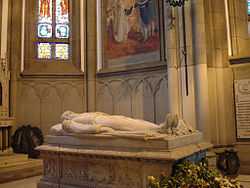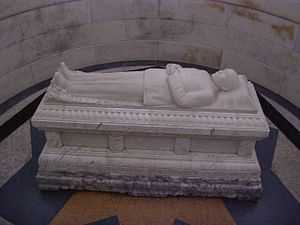Recumbent effigy
| Recumbent Effigy | |
|---|---|
|
| |
| Background information |
Recumbent effigy literally means a "likeness lying in repose"; life-size sculptures of deceased individuals wearing the costume of their station and lying supine. The effigy was usually placed on top of an empty cenotaph tomb chest or, less commonly, a sarcophagus which actually contained the body.
The recumbent effigy decorated Western European church monuments of important people from the Middle Ages onwards, though this art form is known to a lesser degree in other areas of the world.
History

Recumbent effigies were common in Etruscan funerary art, either in pottery or stone; the deceased was shown alive as at a feast, lying sideways, propped up on one arm and sometimes holding a cup. Usually these were rather smaller than life-size. The Romans continued the tradition, though also using many other types of effigy. Faces are often clearly portraits.
The first medieval effigies emerged in the 12th century, executed in low relief, horizontal but as in life. The faces are largely generalized rather than portraits. Gradually these became full high-relief effigies, usually recumbent, as in death, and, by the 14th century, with hands together in prayer. In general, such monumental effigies were carved in stone, marble or wood, or cast in bronze or brass. Often the stone effigies were painted to resemble life, but on the vast majority of medieval monuments, this has long since disappeared. The crossed-legged attitude of numerous mail-armoured knights was long supposed to imply that the deceased had served in the Crusades, but this supposition is unfounded. By the early 13th century, the effigies became raised on tomb-style chests (known as tomb chests or altar tombs) decorated with foliage, heraldry or architectural detailing. Soon such chests also stood alone with varying degrees of decorations. By the end of the century, these often had architectural canopies and figured 'weepers' or 'mourners' (often friends or relatives identified by their coats of arms) were popular decorative features.
Another late medieval fashion was to show the person at death or even in an advanced state of decomposition, perhaps as a secondary effigy. During the Renaissance, other non-recumbent types of effigy became more popular. Variations showed the deceased lying on their side as if reading, kneeling in prayer and even standing. The recumbent effigy only returned to favour during the Gothic revival of the 19th century. Some of the greatest examples of the recumbent effigy in Westminster Abbey in London, Saint Peter's in Rome, Santi Giovanni e Paolo, Venice (twenty-five Doges), and the Basilica of Santa Croce, Florence.
China
In 1929, the mausoleum of Sun Yat-sen opened in Nanjing, China. The body of Dr. Sun Yat-sen (1866–1925), considered the "Father of Modern China", is interred beneath a sarcophagus of white marble with a sculpted effigy of Dr. Sun on top, supine and dressed in conservative modern Chinese attire. The park and mausoleum were designed by Chinese architect Lu Yanzhi, though the recumbent effigy was carved by a Czech sculptor, whose name is rendered in various sources as either Gorge or Gorch.[1][2]
See also
- The Tomb of Antipope John XXIII in Florence is a very grand Early Renaissance wall tomb by Donatello and Michelozzo.
- Funerary art
- Handbook for identification and repair
References
- ↑ Dandan, Wang (2003). "Sun Yatsen Mausoleum". crienglish.com. Retrieved 14 February 2011.
- ↑ "Mausoleum of Dr. Sun Yat-sen in Nanjing: Coffin Chamber". Cultural China. 2007–2010.
